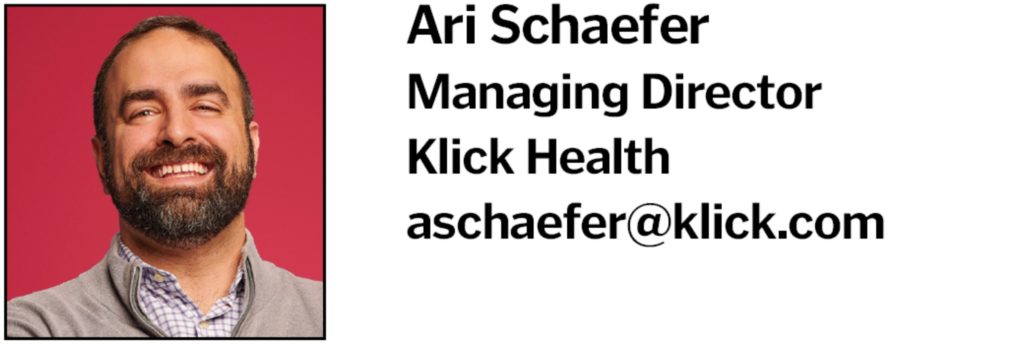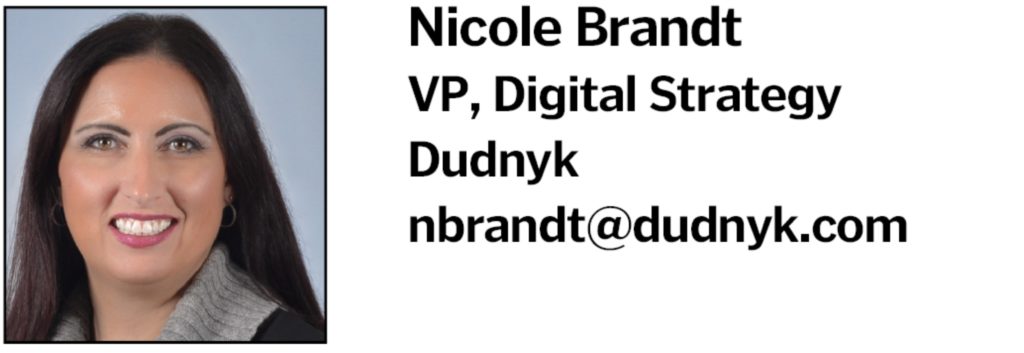PM360 asked experts in reaching and engaging with HCPs how strategies must change as HCPs are dealing with more stress, new technology, and more oversight, including:
- As physician burnout and stress continues to rise—with doctors citing dealing with EHRs one of the reasons for their stress—what can pharma offer HCPs to help ease their burden and improve their ability to help patients?
- What are the best uses of artificial intelligence and predictive analytics to maximize the effectiveness of your sales force and improve a rep’s engagement with HCPs?
- As more physicians lose their prescribing autonomy to IDNs or larger group practices that they join, how must pharma change its strategy to make sure it is engaging with the people who are making the prescribing decisions?
- What other factors/trends in 2019 and beyond will impact pharma’s ability to engage with HCPs, and how must pharma adapt as a result of these changes?
 Burnout and stress is definitely prevalent among HCPs across numerous disease states. Recently, this was evident among nephrologists who felt burned out by balancing high caseloads against the time needed to deal with EHRs.
Burnout and stress is definitely prevalent among HCPs across numerous disease states. Recently, this was evident among nephrologists who felt burned out by balancing high caseloads against the time needed to deal with EHRs.
HCPs have unique, individual challenges in treating their patients. However, they have shared experiences as it relates to the barriers and/or stressors that impact how they engage with patients. These challenges can make the HCPs feel disconnected from their chosen profession and goal to help patients.
While we may not be able to enact a systemic change to reduce this burden, we know that there are proven, evidence-based techniques to help HCPs engage patients efficiently (and meaningfully) and also manage their stress.
One technique is Shared Decision Making (SDM). SDM helps physicians maximize the time they have with patients, ensuring both parties see the conversations as beneficial. Research shows that using SDM results in more efficient and effective interactions between HCPs and patients.
Another technique is Self-Compassion. Research shows that HCPs who are low in self-compassion tend to experience greater levels of burnout. Teaching Self-Compassion and Mindfulness techniques to HCPs can bolster their abilities to manage stress and burnout effectively.
 An interest in medicine is what brings physicians to their field, but what keeps them happy are relationships. To ease burden and burnout, we must focus on reducing the barriers that prevent HCPs from cultivating those relationships.
An interest in medicine is what brings physicians to their field, but what keeps them happy are relationships. To ease burden and burnout, we must focus on reducing the barriers that prevent HCPs from cultivating those relationships.
The emotional take: We can’t prevent burnout, but we can foster empathy. It’s important to understand HCPs within the context of their full, daily lives—not just within the office. Most HCPs prefer language that resembles a natural conversation and messages that are limited to the most salient points. They trust brands that speak human and clearly deliver on their promise. The bottom line: Trust is vital to behavior change; empathy is vital to trust.
The rational approach: We should lean on cognitive psychology to pinpoint and remove friction, freeing HCPs time to spend with patients. Build high-impact, low-time-commitment experiences that reduce cognitive load, streamline administrative tasks, and improve content consumption. For example, bring research to life in a digitally digestible fashion by allowing physicians to skip to specific chapters, dive deep on a data set, or hear need-to-know details via video summaries. Also, it is important to learn HCP preferences and behaviors to curate and present what is most relevant to them.
 In biological terms, stress is the cost of survival in a challenging environment. The business of being a physician in today’s challenging environment could be categorized into the time cost of an increasing administrative burden, emotional cost of patient interactions, and the cost of complexity in decision making. The software industry will eventually standardize and make EHRs more efficient. Medical schools and provider networks must evolve to teach handling humans, not just treatment. Pharma can and must help educate on choice complexity.
In biological terms, stress is the cost of survival in a challenging environment. The business of being a physician in today’s challenging environment could be categorized into the time cost of an increasing administrative burden, emotional cost of patient interactions, and the cost of complexity in decision making. The software industry will eventually standardize and make EHRs more efficient. Medical schools and provider networks must evolve to teach handling humans, not just treatment. Pharma can and must help educate on choice complexity.
Choice complexity is on the rise and we need better content to address it. For instance, how to find relevant data in a mountain of evidence, actualize gene-driven insights, choose a targeted therapy with companion diagnostics when protocols haven’t caught up, or approach evaluating cost to the patient versus the total cost of care calculus. These are areas that pharma can invest in beyond communicating product benefits and in some cases, do. Surgical device and implant companies are a potential model to emulate on deep physician engagement in clinically relevant ways that improve their practice of medicine using the tools of the trade that they produce.
 Pharma brands can use tools such as AI and predictive analytics to transform diffuse data like prescribing and diagnosis patterns, demographics, payer dynamics, marketing activities, and professional affiliations into remarkably accurate predictions about future HCP behaviors. These predictions can come in many flavors, like the likelihood that an HCP will diagnose a certain condition, adopt a certain brand, or respond to a certain channel or message.
Pharma brands can use tools such as AI and predictive analytics to transform diffuse data like prescribing and diagnosis patterns, demographics, payer dynamics, marketing activities, and professional affiliations into remarkably accurate predictions about future HCP behaviors. These predictions can come in many flavors, like the likelihood that an HCP will diagnose a certain condition, adopt a certain brand, or respond to a certain channel or message.
Savvy brands teams can enable sales reps with these predictions to not only more accurately target the right HCPs at the optimal level of investment, but more meaningfully tailor their pitches to each target. That said, to convince their reps to align their efforts with algorithmically generated predictive recommendations, brands must provide them with the “why” behind the “what.”
Model interpretability is a critical ingredient in securing reps’ buy-in. Algorithmic solutions built with interpretability at the core ultimately enable their human counterparts (i.e., reps, marketers, and data scientists alike) to understand the factors that comprise specific predictive recommendations—and in turn, confidently act on them. When considering field deployment, it is critical that teams deploy algorithmic solutions that strike the right balance between raw predictive power and human interpretability.
 The application of AI and predictive analytics (PA) is increasingly adopted to leverage real-world, patient-level data and revolutionize biopharma sales and marketing. For example, AI and PA can be used to identify specific physician practices where undiagnosed patients with the highest probability of having a difficult-to-diagnose condition are currently being managed for other conditions. This “patient finding” enables biopharma companies to help clinicians improve patient outcomes through early diagnosis and management.
The application of AI and predictive analytics (PA) is increasingly adopted to leverage real-world, patient-level data and revolutionize biopharma sales and marketing. For example, AI and PA can be used to identify specific physician practices where undiagnosed patients with the highest probability of having a difficult-to-diagnose condition are currently being managed for other conditions. This “patient finding” enables biopharma companies to help clinicians improve patient outcomes through early diagnosis and management.
Furthermore, AI can also be used to identify the true clinical leaders—those individuals who impact the care of patients far beyond their own practice through their clinical networks. This provides companies with the competitive advantage of being able to measure the true value of a clinician based on their ability to impact treatment decisions and drive the diffusion of innovation. These insights can be leveraged to maximize sales force effectiveness. And maximizing engagements with the most valuable clinicians, as measured through the lens of clinical impact, results in a significantly higher return on investment.
 An AI-powered sales ecosystem makes sure no pertinent marketing data goes to waste, whether it’s an email open, a website visit, a rep conversation, a script, or any other activity. By anticipating relevance with predictive analytics, the rep can provide an HCP with useful information in the format, time, and place that helps them most. And the rep is able to minimize the burden of administrative tasks. Time is used wisely for both reps and HCPs, making it possible for the right information to help patients that much sooner.
An AI-powered sales ecosystem makes sure no pertinent marketing data goes to waste, whether it’s an email open, a website visit, a rep conversation, a script, or any other activity. By anticipating relevance with predictive analytics, the rep can provide an HCP with useful information in the format, time, and place that helps them most. And the rep is able to minimize the burden of administrative tasks. Time is used wisely for both reps and HCPs, making it possible for the right information to help patients that much sooner.
Platforms can also now connect with Veeva to access a rep’s calendar of appointments to obtain scheduling and HCP segmentation information. Using marketing segmentation info allows the sales rep to better plan for their daily calls.
Predictive analytics can also inform conversations with helpful facts such as script-writing history, marketing plan, prior messages presented, and online activity, and giving the rep suggestions of what their next best actions should be. After a call, process automation can help a rep record a call quickly and easily in their CRM system. Optimal solutions are device-agnostic—providing assistance through voice assistants, websites, texts, or emails.
 Health system executives (HSEs) have long been targeted by pharma companies through above-brand “Account Managers,” who help raise awareness about disease impact, gaps in care, and the repercussions of undertreating. But historically these programs have often focused too heavily on educational resources and not enough on actionable solutions—leaving the resolution and implementation up to the health systems and resulting in limited pull-through!
Health system executives (HSEs) have long been targeted by pharma companies through above-brand “Account Managers,” who help raise awareness about disease impact, gaps in care, and the repercussions of undertreating. But historically these programs have often focused too heavily on educational resources and not enough on actionable solutions—leaving the resolution and implementation up to the health systems and resulting in limited pull-through!
As the influence in physician engagement shifts from individuals to organized groups and larger health systems, it’s time for pharma to ramp up their attention at the executive level.
While the opportunities for marketers to demonstrate value run the gamut—programs that proactively screen for at-risk patients, order sets integrated into a doctor’s daily workflow, or automated patient follow-up messaging—the cornerstone for the richest solutions is the same: The Electronic Health Record. For both pharma companies and HSEs, EHR systems deliver the holy grail—HCP workflow integration, rich data capabilities, and sweeping reach. Pharma must collaborate with HSE teams to identify specific opportunities within the EHR to improve quality of care, define uniquely valuable solutions, and develop programs along with selling tools necessary for success.
 In my opinion, there are two major commercial model/analyses to be taken into account as to how pharma must change its strategy to make sure it is engaging with the people who are making the prescribing decisions.
In my opinion, there are two major commercial model/analyses to be taken into account as to how pharma must change its strategy to make sure it is engaging with the people who are making the prescribing decisions.
1. IDN Treatment Pathways:
- Visualize the patient treatment pathways occurring in the IDN by tapping real-world data such as claims, labs, and patient demographics.
- Treatment pathways show product/regimen sequences, timing of interventions, variation to guidelines, including cost or lab data as outcome metrics for pathways.
- Algorithm aggregates the top paths to identify with precision the brand’s key opportunities to show value and gain earlier use in patient treatment.
2. Ecosystem Optimization:
- Analyze the impact of local investments together with national allocations to identify the drivers of market and brand use in local markets (attribution modeling).
- Drive higher brand profitability/growth by aligning the right resources to the right local markets by health systems.
 As pharma marketers, we have always strived to present our brands in the most relevant context possible in order to position our solutions for the right patients, to the right customers, at the right time. But as individual providers have seen their distinct decision-making power erode in place of larger entities such as IDNs and ACOs, we must change our focus. And while the individual has seeded some autonomy to these larger groups, the search for relevance need not change.
As pharma marketers, we have always strived to present our brands in the most relevant context possible in order to position our solutions for the right patients, to the right customers, at the right time. But as individual providers have seen their distinct decision-making power erode in place of larger entities such as IDNs and ACOs, we must change our focus. And while the individual has seeded some autonomy to these larger groups, the search for relevance need not change.
Comparable effectiveness and valued-based medicine are the order of the day. While placebo controlled “safety and efficacy” endpoints may be okay for the FDA, increasingly powerful decision makers are looking for new endpoints—ones that place our products in a broader context. Population health management, patient satisfaction, and value-based outcomes are the new “safety and efficacy” for decision makers. Not everyone will have these data points built into their clinical profiles, but work with your medical teams, your KOLs, and your agencies to find the right context in which to present your products. There is always a way to be relevant. Just understand your customers’ needs are changing, therefore your approach must too.
 This is the era of more data, products, combinations, and complex science than ever before. A new scientific paper is published every minute, and it is our responsibility to cut through the information overload and help HCPs harness this progress to improve patients’ lives.
This is the era of more data, products, combinations, and complex science than ever before. A new scientific paper is published every minute, and it is our responsibility to cut through the information overload and help HCPs harness this progress to improve patients’ lives.
How? Respect the HCPs’ educational journey—see it from their point of view, not yours!
Do your homework: Understand what they need to move from awareness to evaluation, commitment and, hopefully, advocacy. What information have they already absorbed and what do they need to move them forward. Where are they going for it? What formats do they want? Data, analytics, research, and listening are your friends here.
Only after you understand their journey can you tailor content and engagement truly aligned with their needs and preferences. Use strong creative, innovative technology, simple focused storytelling, and make it quick and actionable. Eye-catching tools and execution will grab their attention in a crowded space, but once you’ve got them engaged you owe it to them and yourself to keep your content focused, your message simple. Finally, make sure you are providing a connected and integrated experience to foster that journey.
 The rise of personalized medicine is evolving treatment paradigms and elevating expectations placed on modern physicians.
The rise of personalized medicine is evolving treatment paradigms and elevating expectations placed on modern physicians.
Advancements in therapies, custom-designed to work with a specific patient’s genome, biome, etc., make it more difficult for HCPs to make treatment decisions in the traditional way. Guidelines may evolve to include “fuzzier” domains, where specific drug/drug class recommendations may be replaced with a spectrum of personalized treatment options.
Today’s pharma engagement model with HCPs often focuses on matching a specific therapy with a suitable (often broad) patient cohort. With increased precision comes increased complexity, necessitating a shift in this engagement model.
To help HCPs meet this challenge, pharma manufacturers can enhance their value proposition by: 1) Providing tools to help HCPs explain to patients the probabilities driving treatment decisions; 2) Honing their ability to communicate to HCPs about the role of their therapies in personalized care versus broad patient archetypes; 3) Adapting patient support programs to be more personalized as well, allowing HCPs to better onboard and care for their patients during treatment.
Personalized medicine holds the promise of a leap forward in patient outcomes. This promise can be accelerated by evolving the engagement between pharma and HCPs.
 Building personal relationships between brands and customers has become increasingly difficult, and it is especially so in pharma.
Building personal relationships between brands and customers has become increasingly difficult, and it is especially so in pharma.
As consumers of pharma and non-pharma brands, HCPs have come to expect seamless experiences online. Our non-pharma counterparts continuously refine user experience by gathering data to create unique (“user”) profiles leading to meaningful relationships. They map their audiences’ profiles by media, channel consumption, and device usage. Brands now anticipate their customers’ needs serving the right message at the right time to build meaningful relationships.
In pharma, we can do this too by connecting target data, diagnostic codes, and consumption preferences to reach HCPs. We combine this with customized views of patient experiences to develop data-enriched, HCP-Patient ecosystems. Messages built to encompass everything from clinical data to patient support programs are mapped to effectively move HCPs and patients through the journey together. The key is understanding where the points of interaction between HCPs and patients occur, so we can communicate with HCPs in meaningful ways that lead to what we refer to as the Unifying Effect. This type of engagement can significantly change HCP behavior and maximize brand impact despite the barriers of today’s environment.







